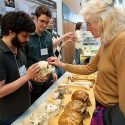Architects chosen to design Wisconsin Institutes for Discovery
Uihlein Wilson Architects of Milwaukee, together with Ballinger of Philadelphia, will design the Wisconsin Institute for Discovery and the Morgridge Institute for Research on the University of Wisconsin–Madison campus, officials announced today.
“UW-Madison is among the nation’s top universities, in terms of competitive federal research grants, and the new Wisconsin Institutes for Discovery – with this incredible design team – will provide another powerful tool to continue that leadership well into the future,” says Chancellor John D. Wiley.
The selection committee was comprised of representatives from the state of Wisconsin, UW–Madison and Wisconsin Alumni Research Foundation (WARF). Its decision was unanimous.
The Uihlein Wilson-Ballinger team has worked together before, bringing Ballinger’s state-of-the-art design of major science research facilities together with Uihlein-Wilson’s highly effective project execution skills. Ballinger has designed major life science/biomedical research facilities at Johns Hopkins University, Wake Forest University, Dartmouth College, the University of Maryland, Brown University, Temple University and the University of Pennsylvania. In addition, Affiliated Engineers, a national company based in Madison, will serve as the mechanical engineer.
According to Carl Gulbrandsen, WARF’s managing director and selection committee co-chair, the winning team demonstrated a superb understanding of the project’s scope and the donor’s vision.
“They understood the importance of creating an environment to facilitate interdisciplinary research, outreach and education, and they also clearly understood the importance and significance of the site in accomplishing this vision,” he says.
The winning team also provided an initial concept of a building having architecture that was contextual, inviting and beautiful, says Gulbrandsen. The concept was one that could easily be expanded to phases two and three of the Wisconsin Institutes of Discovery.
The team will employ a green approach to the building and indicated they will seek Leadership in Environment and Energy Design (LEED) certification. If they succeed, it will be the first such building on the UW–Madison campus.
“This is more than just a building, it’s the physical embodiment of a dynamic new paradigm for research,” says John Morgridge, the primary donor and a member of the WARF Board of Trustees.
Tashia Morgridge, a retired special education teacher, likes the architects’ idea of tying research to education as a basic tenet of design. “We are confident that this team will design a facility that helps enable the mission of the Wisconsin Institute for Discovery and the Morgridge Institute for Research to facilitate research and learning in the biological and biomedical sciences in an interdisciplinary, collaborative environment,” she says.
The couple also expects the design to capture the imagination of the campus, the Madison community, the state and the larger scientific community.
The project includes the public Wisconsin Institute for Discovery and the private Morgridge Institute for Discovery, made possible by a $50 million gift from the Morgridges, matched by $50 million from WARF and $50 million from the state, providing a total of $150 million for the project.
Marsha Mailick Seltzer, interim director of the Wisconsin Institute for Discovery, says the faculty will be the key to the project’s ultimate success.
“We have the opportunity to take our experience in cross-disciplinary research to a new level,” she says. “I want to make sure the science conducted in the institutes will make a difference in people’s lives.”
The Morgridges’ gift is the largest ever to benefit the university.
The new institute will help the university compete for the best and brightest faculty because it will be an environment in which the world’s leading scientists will want to work.
The institute is being designed to benefit the UW–Madison community and the state of Wisconsin by generating collaborative research that will spur new inventions, new treatments and cures for disease, and economic development for the region.
Construction is expected to begin by early 2008, with completion in 2010.

